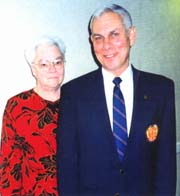
Co-Founders U.S. Chito-ryu Karate Federation
Founders Forum - 2001
Technique-Fitness-Injuries-Age-Respect
Technique, fitness, injuries, age and respect are five areas of living and life that need to be addressed by the martial arts: student, instructor, sports enthusiasts and older teacher or student.
Technique:
Every traditional martial artist recognizes the importance of striving to achieve excellence in their technique. To attain that end the
martial artist also must recognize the importance of physical fitness.
Physical fitness:
A person must be physically fit, to be able to achieve the plateau of excellence you are striving for. Next we must ask the question,
"can a student be physically fit but be injured?" sure he can. He may not be in peak condition but he may still be a better
person than one who never trains and has no injuries. So once again (whether the student is a beginner, or an advanced student) the injury
or injuries will have an effect upon the way they train and practice.
Age:
The next area we must consider is the age of the martial arts student. Is it feasible for us to expect a student (beginner or advanced) to
train at the same level of intensity as when he was younger the answer to this question is very obvious; it is no! Older people need a longer
time to warm up, and in many cases have a much more difficult time in a high endurance type of class than younger persons. In short, older
students do not have the endurance of younger people.
Respect:
Last, but perhaps most important is respect. You do not demand respect, you earn it. One thing I have discovered is that respect must be given
to be received. High rank demands respect at first. But it must be earned, and re-earned on a daily, weekly, monthly and annual basis. Nothing
in life is free; you have to earn it.
The next time a new student arrives at your dojo, look him or her over. Are they young or a little older than the rest of the students? Do they have any injuries (perhaps not listed or unannounced)? What is a new student's fitness level: poor, good or above average. How is his basic technique looking? Is this his first class or had he studied somewhere before? If so what was his/her rank? How long did he/she study? How long has it been since the student last trained in any physical activity?
Lastly, treat the new student (or returning student) with respect. Students do not need to be be1itt1ed, intimidated, threatened or impressed. They need friendship, guidance, training and a feeling of belonging, without these, their days as a member of the dojo will be limited, and they will be gone. We will never know if the person we run off could have been another Chitose Sensei or Funakoshi Sensei.
Excellent technique is our goal, but self-understanding must be an aim of traditional martial arts training.
